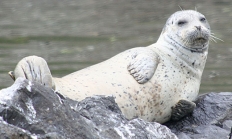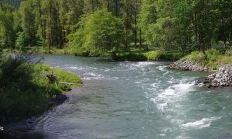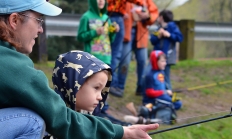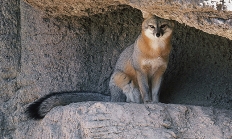
Search myodfw.com
The body of the Pacific harbor seal is plump but tapers to small rear flippers permanently extended posteriorly. The head is large and rounded, the eyes are large, the limbs are short, and the nostrils sit dorsally on the muzzle. The nostrils can be closed when this seal dives. The tongue is notched at the tip. The pelage consists of long overhairs that overlay short underhairs. Markings are extremely variable, but in general the pelage is gray or brownish gray with numerous small spots of black that may coalesce to form splotches. Pacific harbor seals have been observed ashore at

Features: Mule deer are larger and lighter in color than black-tails. Mule deer have a thinner “ropelike” tail that is white with a black tip. Their antlers are forked, as opposed to having a main beam. And as their name implies, they have large ears, like a mule, that stand at an angle. Habitat: Mule deer occupy a wide range of habitat types; some live in desert shrub-steppe, some in woodlands, and some in conifer forests. In general, however, mule deer occupy the more open, rugged areas. Although mule deer commonly are considered “browsers," they consume a wide variety of

Nick Myatt, Region Manager Golden eagle research in northeast District wildlife staff in Wallowa County, in partnership with the U.S. Fish and Wildlife Service and the Nature Conservancy, began a pilot project to study the survival, movement, and reproductive success of golden eagles. During the pilot phase, ODFW staff tested methods of capture as well as telemetry units to determine feasibility for a longer-term study. The first capture event during this pilot project took place in mid-December 2024. USFWS provided four GPS units for this pilot year. The data from golden eagles captured in northeast Oregon during this pilot phase

Features: Dungeness crab can sometimes be confused with rock or other crab species. However, it is easily identified by its white-tipped claws and reddish-brown to purple color. Habitat: Adult Dungeness crab forage on a number of fish and invertebrate species. They can be found throughout the sandy and muddy areas in the shallowest parts of lower estuaries all the way to depths of almost 1,500 feet. Techniques: There are many kinds of crab catchers – from crab pots and rings, to traps you can cast with a fishing rod. You can easily crab from a dock in many coastal bays

The Sherars Falls Adult Salmon and Steelhead Trap is located at river mile 43 on Oregon's Deschutes River. The trap captures an unknown proportion of adult fall Chinook salmon and summer steelhead that are passing over Sherars Falls.
Cabela's - 7555 SW Nyberg St Tualatin, OR 97062


Of the three U.S. and Canadian forest hawks known as accipiters, this is by far the most impressive because of its size and aggressiveness. Like others of the genus it is morphologically adapted to maneuvering through forest landscapes and usually uses an ambush approach to capturing prey; although if prey tries to escape, it quickly pursues. From Turkey to Japan, goshawks are favored over falcons for falconry, and a limited number of permits are issued in Oregon for taking goshawks for falconry purposes. The Northern goshawk has short, broad, round-tipped wings and a long tail. It is approximately the size

The Red crossbill is aptly named for its unusual bill configuration of crossed upper and lower tips of the mandibles which it uses to pry seeds primarily from native conifer cones. Degree of bill crossing is variable depending on wear, and it can have a right or left cross. Adaption to varied conifer cone structures and sizes has resulted in a diversity in body size, bill size and shape, and palate configurations in Red crossbills. Juveniles are brown with heavy streaked undersides and faint buff wing bars. Mature males are red with dark brown flight feathers and tail; first-year males

The kit fox is the smallest canid that occurs in Oregon. It has the typical canid conformation: the body is slim, the legs are long and thin, and the ears are large and erect. The tail is about 40 percent of the total length and is tipped with black, but has no dark mane on the dorsal surface. The feet and legs are whitish interiorly, light rusty-brown posteriorly. The dorsum is grizzled brownish-gray medially blending to grizzled gray then to light buff laterally and finally to white on the chest and venter. The head and posterior surface of the ears

The Pacific white-sided dolphin is most abundant in the Southern California Bight in winter, but move further north, off Oregon and Washington in summer. These animals can be found from the tip of Baja to the Aleutians and the western Pacific from the Kuril Islands to Japan. They prefer deep, off-shore waters, so sightings are usually limited to recreational and commercial fishers. The Pacific white-sided dolphin is about seven or eight feet long. It has three colors: the chin, throat and belly are creamy white; the beak, flippers, back, and dorsal fin are a dark gray, and there are light

When a turkey is shot in the head with a shotgun, death is usually instant. However, a turkey may flop on the ground for several seconds, even up to a minute, after it’s “dead.” In this case, the turkey isn’t going anywhere so simply wait for it to go still. If the bird is wounded and laying with its head up, you may need to shoot it again – in the head with a shotgun, or in the spine or vitals with an arrow. Don’t try to ring the neck of a bird that’s still alive but not going anywhere

The common porcupine is a large, short-legged rodent with up to 30,000 bare-tipped quills (modified hairs) covering the upper parts of the body and the dorsal and lateral surfaces of the tail. The quills are scattered among much longer, course guard hairs; the underfur is woolly. The quills are arranged in rows across the body, the longest quills are on the rump, the shortest on the face. Quills used in defense are replaced commencing about 10-42 days after loss. The overall color of the porcupine is dark brown or blackish. The front feet have four toes, the rear feet five

Features: Gaper clams have large "neck" housing the two siphons that protrude above the substrate surface when feeding. Protective leathery plates are found just below the siphon tips and feel rough to the touch. Gapers are unable to retract their neck entirely into the shell, producing a "gape" in the shell. It is common for algae to grow on their necks and gaper pea crabs to dwell inside the shell with the gaper clam. Habitat: Gapers can be found in high salinity sandy and/or muddy areas in most of Oregon's larger estuaries. Tillamook, Netarts, Yaquina, and Coos are favorite bays

Willamette fishing December 4, 2025 Best bets for weekend fishing: The Willamette River and other water bodies are increasing in activity. Several waterbodies will be stocked with trout this week. Cascade Hike-in Lakes offer beauty, serenity, and the potential for untrammeled fishing opportunities. Trout stocking Stocked the week of Nov 17-21: Row River nature park (formerly Cottage Grove Lake) Scheduled to be stocked the week of Nov 24-28: Walter Wirth Lake, Mt Hood Pond at MHCC campus, Waverly Lake, Junction City Pond, Timber Linn Lake. Check the 2025 trout stocking schedule Trout stocking maps Check out the ODFW fishing and

Find maps, boundary information and the percent public land in the Chetco Unit.
The gray fox is among the smaller canids in Oregon. The basic color of the gray fox is grizzled gray, but the stiff middorsal hairs have long black tips that extend onto the tail as a black mane. Guard hairs are banded white, gray, and black. The throat, venter, and inside of the legs are white; a cinnamon-rufous border to the white throat extends on the flanks and underside of the tail A blackish patch on the side of the face extends onto the lower jaw and a grayish black "exclamation point" extends upward from the interior margin of each

Features: When in the ocean coho salmon can look very similar to Chinook salmon . However, coho will have a white gum line on the lower jaw with darker color both inside and outside of the gum line, and will only have spots on the upper lobe of their tails. When coho return to freshwater they become red on their sides and dark greenish on their backs, heads, and fins. Coho adults may reach 25 pounds or more, but rarely exceed 15 pounds. Habitat: Small, relatively low-gradient tributary streams with pea to orange-sized gravel for spawning and juvenile rearing. Coho

